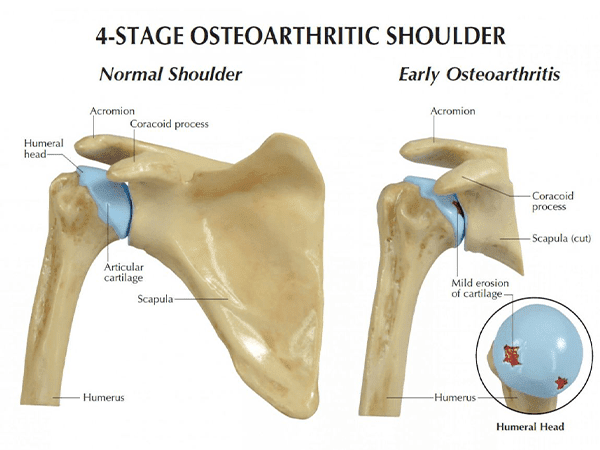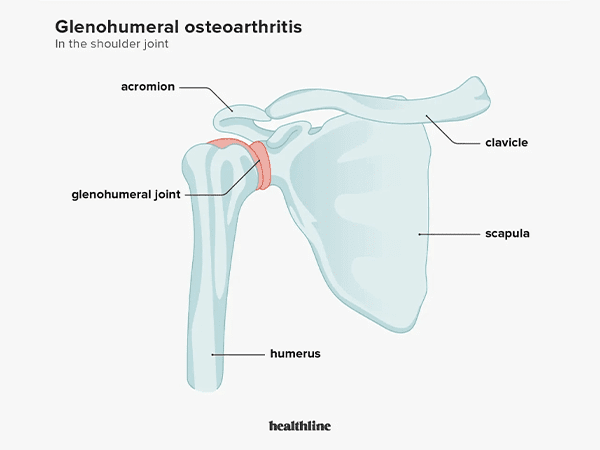Shoulder osteoarthritis, also known as glenohumeral osteoarthritis (GH OA), is a type of arthritis that occurs when the cartilage in the shoulder joint wears away. This can cause pain, stiffness, and decreased range of motion in the shoulder.
The shoulder joint is a ball-and-socket joint that allows for a wide range of motion. The humerus (upper arm bone) fits into the glenoid fossa (socket) of the scapula (shoulder blade). The cartilage that lines the joint helps to cushion the bones and reduce friction during movement.
In osteoarthritis, the cartilage in the shoulder joint breaks down over time. This can happen due to several factors, including:
Age: Osteoarthritis is most common in people over the age of 50.
Injury: A shoulder injury, such as a fracture or dislocation, can increase the risk of developing osteoarthritis.
Occupation: Certain occupations, such as manual labor, can put extra stress on the shoulder joint and increase the risk of osteoarthritis.
Genetics: Some people are more likely to develop osteoarthritis due to their genes.
The symptoms of shoulder osteoarthritis can vary from person to person. Some common symptoms include:
Pain in the shoulder, especially with movement
Stiffness in the shoulder
Decreased range of motion in the shoulder
Crepitus (a popping or grinding sound) in the shoulder.
Weakness in the shoulder
If you have any of these symptoms, it is important to see a doctor to get a diagnosis and treatment.

Medication: Over-the-counter pain relievers, such as ibuprofen or naproxen, can help to relieve pain and inflammation. Prescription pain relievers, such as opioids, may be necessary for severe pain.
Physical therapy: Physical therapy can help to improve range of motion, strength, and flexibility in the shoulder.
Injections: Injections of cortisone or hyaluronic acid can help to reduce pain and inflammation.
Surgery: Surgery may be an option for people who do not respond to other treatments. Surgery options include:
Arthroscopy: This minimally invasive surgery allows the doctor to see inside the joint and make repairs.
Total shoulder replacement: This surgery replaces the humerus and glenoid with artificial parts.
The goal of treatment for shoulder osteoarthritis is to relieve pain and improve function. With proper treatment, most people with shoulder osteoarthritis can continue to live active and independent lives.
Who Gets Shoulder Osteoarthritis?
Shoulder osteoarthritis most often occurs in people who are over 50 years old. However, shoulder osteoarthritis can be seen in younger people due to an injury or trauma, such as a fracture or dislocated shoulder. Osteoarthritis can also run in families.
What Causes Shoulder Osteoarthritis?
If you have shoulder osteoarthritis, you may experience pain, stiffness, and inflammation in the shoulder joint. You may also have difficulty moving your arm. The pain may be worse with use of the shoulder joint. The stiffness may make it difficult to get dressed or bathe. The inflammation may cause redness, warmth, and swelling in the shoulder area.
If you have any of these symptoms, see your doctor. They can diagnose shoulder osteoarthritis and recommend treatment options. Treatment for shoulder osteoarthritis may include:
Medications: Your doctor may prescribe medications to help relieve pain and inflammation.
Physical therapy: Physical therapy can help improve range of motion and strength in the shoulder joint.
Injections: Your doctor may inject a corticosteroid medication into the shoulder joint to relieve pain and inflammation.
Surgery: In some cases, surgery may be necessary to repair the shoulder joint.
With proper treatment, most people with shoulder osteoarthritis can manage their symptoms and maintain a good quality of life.
How Do You Treat Shoulder Osteoarthritis?
Shoulder osteoarthritis is a condition that occurs when the cartilage in the shoulder joint breaks down over time. This can cause pain, stiffness, and reduced range of motion. There are a number of treatments available for shoulder osteoarthritis, including:
Non-surgical treatments: These treatments are often the first line of treatment for shoulder osteoarthritis. They may include:
Resting the shoulder: This can help to reduce pain and inflammation.
Ice and heat therapy: Applying ice or heat to the shoulder can help to reduce pain and inflammation.
Medications: Over-the-counter pain relievers, such as ibuprofen or acetaminophen, can help to reduce pain. Prescription pain relievers, such as nonsteroidal anti-inflammatory drugs (NSAIDs) or corticosteroids, may also be helpful.
Physical therapy: Physical therapy can help to improve range of motion, strength, and function in the shoulder.
Arthroscopy: This is a minimally invasive surgery that allows the surgeon to see inside the joint and make repairs.
Total shoulder replacement: This is a surgery to replace the entire shoulder joint with an artificial joint.
Resurfacing arthroplasty: This is a surgery to resurface the joint surfaces with metal or plastic implants.
The best treatment for shoulder osteoarthritis will vary depending on the individual’s symptoms and severity of the condition. It is important to talk to your doctor about the best treatment options for you.

- Avoid activities that aggravate the shoulder. This may include activities that require overhead use of the arm, such as sports or lifting heavy objects.
- Strengthen the muscles around the shoulder. This can help to improve stability and reduce pain.
- Maintain a healthy weight. Excess weight can put extra stress on the joints, which can worsen osteoarthritis symptoms.
- Eat a healthy diet. A diet rich in fruits, vegetables, and whole grains can help to reduce inflammation and improve overall health.
- Get enough sleep. Sleep is important for healing and reducing pain
- Manage stress. Stress can worsen pain and inflammation. Find healthy ways to manage stress, such as exercise, relaxation techniques, or spending time with loved ones.
